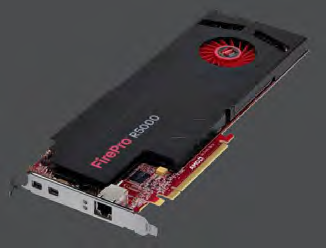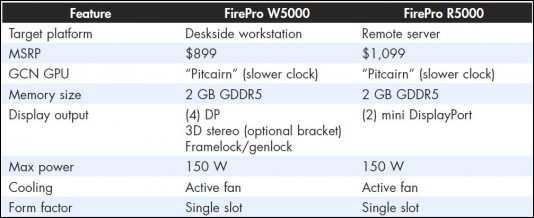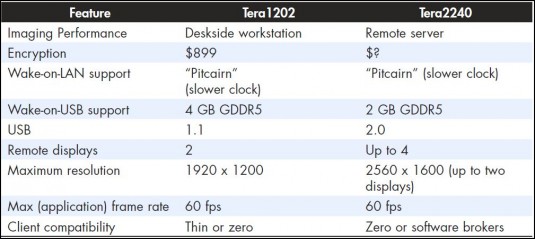AMD is teaming up with Teradici to offer an end-to-end solution for desktop workstation replacement and VDI deployment. Alex Herrera takes a close look.
By Alex Herrera

AMD has released the FirePro R5000 remote graphics card, and in the process is building out a growing family of products targeting a partly new, partly rehashed take on the client/server computing model. Remote server-based graphics technology promises a simpler, easier, and potentially cheaper means to deliver the same high-performance graphics experience as a client workstation can. “Promises” is the operative word, as the concept in practice has yet to deliver on those goals, especially when it comes to performance.
The market and hype for centralized server-based rendering technology have ebbed and flowed over the past few decades. There was the emergence of the workstation, replacing the dumb mainframe-connected terminal, delivering high-performance graphics to the user’s desk. Later came the “thin-client” revolution that promised to remove the bulk of that intelligence and computation from the desk and give it back to the server. But with the advent of low-cost, high-performance workstations, spawned by advances in PC technology, the economic benefits of server-based graphics withered. And with the prospect of remote rendering facing the daunting obstacle of insufficient network infrastructure, broad-based deployment of high-performance, server-based graphics never came to pass.
But remote graphics approaches are back on the rise. Top workstation vendors Dell and Fujitsu have recently joined HP—who itself took over as torchbearer, carrying the technology on from former workstation stalwarts Sun and SGI; together they are all re-introducing remote visualization technology.
The AMD FirePro R5000
With its new FirePro R5000 card, complemented by a broad set of compatible client options, AMD promises a remote graphics solution that delivers a quality visual experience across a network. The growing FirePro R (standing for Remote) series card family shares core GPU technology with its sister “S” series (“S” for server and/or supercomputer) and W (Workstation) series.

Specifically the new R5000 shares many of the specs of its client-side sibling, the FirePro W5000. It sports the same Pitcairn GPU, the flagship of the graphics core next (GCN, a.k.a. Southern Islands) generation, launched a year ago. Touting 1280 GCN “compute units,” Pitcairn can deliver over 2 TFLOPS of performance, making it AMD’s highest-performing single-chip GPU. Paired with 2 GB of GDDR5 memory and a direct network connection, the R5000 not only renders imagery, but streams the resulting encoded video to up to four remote clients.
AMD has set the MSRP of the R5000 at $1,099.
AMD adopts Teradici’s PCoIP technology … in hardware
The R5000 looks a lot like the W5000. They are full-length, full-height, x16 PCI Express 3.0 cards with equivalent graphics performances, courtesy of the same Pitcairn GPU. But the R5000 has one significant additional responsibility the W5000 doesn’t: packaging up rendered images and transmitting to a remote IP address. And that’s where the similarity ends, as the R5000 integrates unique technology, courtesy of AMD partner Teradici. The company’s PC over IP (PCoIP) technology, already featured in comparable remote graphics solutions from Fujitsu, Dell, and IBM, provides the means to turn frames into a suitable streaming format.

Why buy Teradici’s technology? Couldn’t AMD have simply used an existing, standard, readily-available codec and network technology to accomplish the same thing? Not really. Yes, a solution that simply encodes the sequence of frames as a video stream using an H.264 codec (or any other video-centric codec, for that matter), then simplistically transmits across whatever network protocols are provided, does theoretically work. But it wouldn’t necessarily work well.
A quality, workstation-caliber experience requires high fidelity with all visual types: synthetic imagery, natural images and video, and text. And the most effective means to encode one is typically not the best means to encode another. Accordingly, one of the key features of PCoIP is multi-modal compression, which identifies and decomposes images, separating types and encoding them through the optimal means for each type.

Where and how does the R5000 integrate PCoIP technology? Well, note that the R5000 sports one fewer output port than the W5000, two rather than the three that Pitcairn can handle. That third GPU video interface is (most likely) the dedicated input to the Teradici Tera2240 chip, which (we assume) must implement some sort of on-chip frame store capable of retaining two or more frames. (It’s possibly just two, current and backward reference, frames since the need to limit latency probably precludes Teradici from implementing forward reference frames.)
The Tera2240 is the latest PCoIP chip from Teradici, substantially improving on the features embedded in previous incarnations, both hard (chip) or soft (code). Key enhancements from the previous Tera1202 chip include twice the number of remote clients and higher resolution streams.
Teaming with Teradici also saves AMD the additional chores of creating its own clients and building in support for the major virtual desktop infrastructure (VDI) solution. With PCoIP, FirePro remote graphics is compatible with both VMware (ESX Server) and Citrix (XenServer), as well as direct GPU pass-through.
Compelling advantages … but not without drawbacks
Remote graphics solutions like the FirePro W5000 plus Teradici PCoIP enables thin or “zero” clients equipped with Teradici software to replace relatively “heavy” deskside workstations. Teradici software can be used on many types of devices including Wintel PCs, and Android or iOS smartphones and tablets.
The resulting end-to-end solution can do one of two things: either move the user’s workstation off the desk and into the datacenter, or create a multi-client VDI server. In the former case, the user is still tied one-to-one to a workstation, it’s just that the workstation is now in the other room. In the latter case, one server installation is replacing potentially several client-side workstations, from anywhere on campus (across the LAN) to anywhere in the world (via the WAN).
But while server-side graphics functionality is in theory the same as client-side, the performance might not be. Yes, long-haul transmission means tighter constraints on bandwidth, which (depending on quality of service) will translate into some relative degradation on image resolution or frame rate. But that’s not the lesser of the drawbacks that go with large-distance remote visualization. The biggest is latency.
The farther away the client is—in network hops, not miles—the bigger a problem latency will be. Latency is, of course, the primary reason that remote, high-performance graphics has never previously caught on in any extensive way. If the benefits of remote visualization are so compelling, then it would be the rule rather than the exception already. But network performance, and latency in particular, have limited acceptance of past implementations.
Exactly how much latency is too much? Well, Citrix, a leader in VDI technology, says 200 ms. Any longer a delay in the system, and Citrix finds users will be more frustrated, less productive, and get downright irritable working for very long. And 200 ms is the same limit quoted by AMD’s arch-rival Nvidia. Promoting its new server-side, VDI-capable graphics solution, VGX, Nvidia has gone to great lengths to get that round-trip latency down below that threshold, not only trimming every possible millisecond out of its own domain (GPU and drivers) but teaming up with partners in VDI and network service providers to do the same in their domains.
Teradici’s target is in the same range, shooting for PCoIP operation in the 150 to 250 ms range, indicating that the actual number will depend (of course) on the performance characteristics of the network provided, something they can’t control.
The challenges ahead
AMD has not one but two hurdles to clear in order for its budding R Series of FirePro cards to succeed. First, server-based graphics have to be accepted by more than a niche segment of the market. The technology has to do better this time around than in previous attempts to move graphics to the datacenter. Second, it’s going to have to once again fight it out with Nvidia to get whatever business is there to be had.
Fending off Nvidia, which has a head-start in this pursuit, won’t be easy. But getting the bulk of the workstation user base convinced of the value proposition may be the bigger hurdle. As evidence consider the blade workstation, which has been offered for several years now and offers some of the same benefits as remote graphics including less crowded offices and increased security and manageability. Yet blade workstation volume has never grown beyond a relative trickle.
But really, this card isn’t particularly well-suited to the one-to-one/remote-workstation-to-user model for which blade workstations are meant. This card is high end and high performance. We don’t see much point putting a relatively expensive, high-performance card in the back room, if it’s going to be tied to one user. The one-to-one remote graphics model better serves financial, health care, government, and office work, where demand is not high and other benefits (e.g., freeing up desk space) are compelling; the cards that best fit that segment would be lower-end cards like AMD’s RG220, not the R5000.
No, the R5000 is better suited to shared, VDI-type usage, particularly in low, more deterministic latency configurations like across the LAN. And thinking WAN, there are other usage modes, where latency beyond that 200-ms threshold isn’t a critical problem. Consider applications that want to house dynamic, evolving datasets that are simply too big to be practical to transmit to satellite offices or campuses on a frequent basis (e.g., a large-scale seismic dataset). In that case, even a second of latency in remote visualization is better than minutes or hours to move a dataset, so users will be more tolerant of delays and lack of interactivity.
The other potential Achilles heel is what helped derail the thin-client revolution years ago: the lack of a clear-cut cost advantage over deskside workstations. Citrix thinks 6 to 12 users can share a virtualized, server-side, high-end graphics card, something like AMD’s FirePro R5000 or Nvidia’s Quadro 5000. Amortize the Quadro 5000’s $1,700-ish price across 6 users, and that’s still more dollars spent per user than if the buyer had configured six deskside workstations with low-end Quadro cards.
Then there are potential issues of personal preference and even prestige. Suppose an IT manager felt justified in pulling a deskside machine from a designer in favor of a shared GPU in the datacenter; there’s no guarantee the senior, veteran engineer, who’s always had his own workstation, is going to be in favor of the change. And that premise alone might deter decisions to implement any replacement of dedicated workstation graphics for shared server graphics to any substantial degree.
Still, there are absolutely places where—assuming adequate performance is attainable—remote graphics is a win. The target customer is in applications where there is more of a need for viewing than for creating. Applications such as collaboration across distances is a good example, and digital artists working in the movie industry are people who have need of this. An effects director can take his laptop down to Hollywood and then remotely tap into terabytes back at the home studio and experiment with requests from the director in real time.
Latency is the key
Whether remote graphics ultimately ends up on top of the IT department’s wish list, or on top of the IT trash heap, latency will again be the critical metric to make or break that value proposition. If vendors like AMD, Nvidia, Citrix, VMware, and Teradici can make these environments responsive enough for interactive use, the proposition will be a compelling one, giving IT directors some real choices to consider in their future workstation strategy. If not, solutions like AMD’s FirePro R-series will end up shipping a trickle of volume into a handful of market niches.
We think the final answer will be somewhere in the middle. The organization’s power users will still have hefty workstations at their desks, but a broader range of users—both on campus and off—will be able to leverage the technology to more effectively tap into visual content.
Alex Herrera is a senior analyst with Jon Peddie Research.





